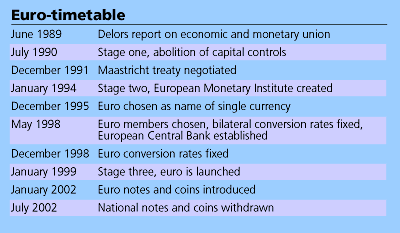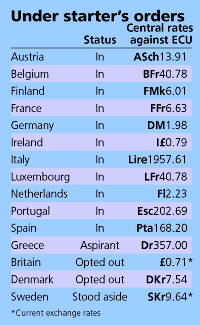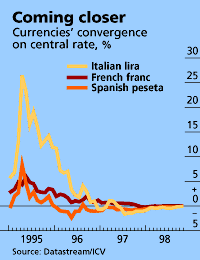|
The French even tried to ensure that the founding articles of Europe’s monetary union included commitments to economic growth, as well as price stability. When the outgoing German finance minister, Theo Waigel, proposed a stability pact with automatic fines to enforce fiscal prudence on euro members, the French insisted on making the fines discretionary and even on calling the thing the stability and growth pact, betraying by its very name a hard-fought compromise between German and French priorities.

France also sees a big role ahead for “euro-11”, an informal grouping of euro-member finance ministers that will act as a political counterweight to the ECB. And in May this year President Jacques Chirac fought tenaciously to install a Frenchman, Jean-Claude Trichet, as chairman of the ECB itself, infuriating other governments that had agreed on a Dutchman, Wim Duisenberg. The other countries feared that French dirigisme might capture the bank in its formative years. A messy compromise was reached: Mr Duisenberg got the job, but said that he planned to step down halfway through his eight-year term in favour of a French candidate, presumably Mr Trichet.

From EMS to euro

Tensions and teething troubles notwithstanding, preparations for the single currency have been speedy. The project began to take shape in 1987-88 with papers from Edouard Balladur, then French finance minister, and Hans-Dietrich Genscher, German foreign minister. Mr Balladur argued that attempts to tie exchange rates together through the European Monetary System (see article) were producing an “abnormal result” by virtue of German dominance of the system. He suggested that “rapid pursuit of the monetary construction of Europe the only solution.”

Mr Genscher, to some people’s surprise, given Germany’s traditional attachment to an independent monetary policy, replied that “a European currency area and a European central bank” could indeed represent an advance, provided that the central bank was constructed along strict Bundesbank lines. This strongly suggested that a political bargain already existed between the French president, François Mitterrand, and the German chancellor, Helmut Kohl, to make a single currency their joint legacy to Europe.

At their summit meeting in Hanover in June 1988, EU heads of government duly invited the president of the European Commission, Jacques Delors, to assemble a committee and produce a report on economic and monetary union. The Delors committee returned a year later with proposals for a union in three stages. A somewhat vague first stage would involve a concerted effort to co-ordinate national monetary policies. In stage two, the exchange rates of currencies destined to enter the monetary union would not be realigned save “in exceptional circumstances”; and a European Monetary Institute would be set up as the precursor to a true European central bank. With stage three would come a single currency under the new central bank’s authority.

Europe’s leaders decided to begin stage one on July 1st 1990, the date already set for a general abolition of capital controls within the EU. They agreed to convene an inter-governmental conference (IGC) to draft the treaty commitments needed to underpin a single currency. This conference opened in Rome in December 1990, and ended a year later at Maastricht in the Netherlands. It produced the “Maastricht treaty”, one of the most ambitious and contentious documents in EU history.

One source of dissent was Britain. Margaret Thatcher had been ousted as prime minister partly because she was so virulently opposed to closer European integration. Her successor, John Major, stayed hostile to a European single currency whatever the details of the project might be. Yet he did not want to rule Britain out for ever; and he realised the other EU countries were determined to go ahead. So at Maastricht he won the right for Britain to stay out of the single currency at birth, but to “opt in” later if it wanted and was qualified to do so. A similar concession was made to Denmark after Danes rejected the Maastricht treaty at a referendum in June 1992.

Even so, British opinion was perturbed by the sweeping language of the treaty, which promised not only a monetary union, but also a closer political union. This additional element followed a last-minute decision, also at the initiative of Mr Mitterrand and Mr Kohl, to hold an IGC on “political union” in parallel with that on monetary union. All this proved too much for public opinion in many countries. Rows about national and European identity cut across party lines. In France, where the Maastricht treaty was put to a referendum after the Danes had said no, the majority in favour was a wafer-thin 51%. Ratification was tortuous and contentious in other countries too.

Maastricht muddles

Still, the Maastricht treaty held, and its goal of a single currency was robust enough to survive several tricky moments. The worst came with the period of exchange-rate turmoil in 1992-93. A wave of speculative attacks temporarily destroyed the capacity of EU countries to maintain exchange rates within the European Monetary System.

The EMS had been launched in 1979 to help stabilise exchange rates across the European Community. The Delors prescription for “stage two” of monetary union would require exchange rates within the EMS to become progressively more rigid, creating a de facto monetary union as the precursor of a single currency.

Yet in September 1992 the British pound and the Italian lira went crashing out of the system. Speculators had guessed correctly that neither government could afford to keep interest rates high enough for long enough to withstand their attacks. Emboldened, they turned on other currencies. The Irish punt, the Portuguese escudo and the Spanish peseta were all devalued. The climax came with a run on the French franc in July 1993. EU governments responded by changing the rules to allow exchange rates in future to fluctuate by up to 15% either side of their central rates, in place of 21/4%. This new flexibility, and some belated help from the Bundesbank, gave the franc a respite, saving the EMS from outright collapse.

Many sceptics were prompted to ask what hope there could be for a monetary union among countries unable to keep national currencies aligned. Mr Major wrote in The Economist that continuing “to recite the mantra of full economic and monetary union . . . will have all the quaintness of a rain dance and about the same potency.” Yet most other EU governments read events differently. They concluded that full monetary union should come as soon as possible, to prevent such turbulence hitting their currencies again.

The “second stage” of monetary union began on January 1st 1994. The European Monetary Institute opened its doors in Frankfurt under the directorship of Alexandre Lamfalussy, a Belgian who had previously run the Bank for International Settlements. In December 1995, meeting in Madrid, EU leaders confirmed their intention to launch a single currency on January 1st 1999. They decided that the new currency should be called the “euro”; and, as expected, confirmed that it would inherit the value of the ecu, a synthetic currency tied to a basket of European currencies.

For those countries hoping to join the single currency, 1996-97 was marked mainly by the struggle to bring their economies into line with the strict pre-entry criteria insisted on by the Germans and written into the Maastricht treaty. Under these so-called convergence criteria, a country’s inflation and long-term interest rates had to be within 11/2 percentage points and two points, respectively, of the three best EU performers on inflation; a budget deficit below 3% of GDP; public debt that was under 60% of GDP; and a record of exchange-rate stability, defined as having observed the “normal” EMS margins for two years.

Plenty of let-out clauses from these criteria were written into the treaty; they were exploited, and there was some judicious fudging of the figures. Yet most countries made genuine reforms as well. Italy, in particular, surprised its neighbours, and the financial markets, with its willingness to impose tough fiscal measures. When EU leaders met on May 2nd this year, they decided that 11 countries had made the grade. Greece wanted to join, but had not met the criteria. Britain and Denmark, which had met most of them, exercised their opt-outs. And Sweden, which had no formal opt-out, chose to stand aside; it also failed the criterion of exchange-rate stability.

If any of the 11 countries about to join the euro are suffering last-minute doubts now, they are prudently keeping quiet. There is no going back. A striking feature of the single-currency arrangements is that they make no provision, legal or practical, for any participant’s withdrawal or expulsion. In this adventure, Europe has left itself with no choice but to succeed.



|


